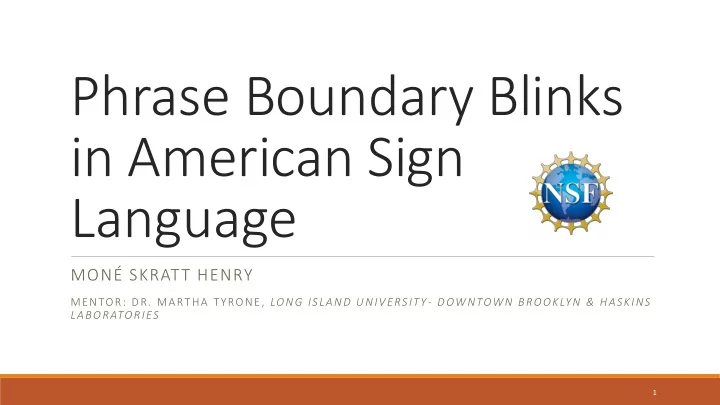

Phrase Boundary Blinks in American Sign Language MONÉ SKRATT HENRY MENTOR: DR. MARTHA TYRONE, LONG ISLAND UNIVERSITY- DOWNTOWN BROOKLYN & HASKINS LABORATORIES 1
Background • American Sign Language (ASL) is a sign language used in the United States and Canada • Population: ~250,000 signers in US • In ASL, besides using hands as articulators, other parts of the body function to provide important grammatical information. • Nonmanual articulators : body parts. • Nonmanuals : movements of those body parts. 2
Background (cont.) • Wilbur (1994) found that the lower face nonmanuals (e.g., mouth shape) are used for adjectival and adverbial functions . • Upper face nonmanuals provide grammatical and prosodic functions (e.g., eyebrow movement for interrogatives). • Blinking is example of upper face nonmanual. 3
Nonmanual Examples Lower nonmanual Upper nonmanual 4
Background (cont.) • Blinking behavior in speakers of English is different than signers of ASL. • Hypothesized to result of visual nature of sign language (Baker & Padden, 1978). • Baker and Padden (1978) suggested that blinks occur systematically at phrase boundaries. • Wilbur (1994) observed that blinks were sensitive to syntactic structure. • However, blinking location and frequency are highly variable due to differences in signers and rate of production. 5
Research Questions • Do native signers of American Sign Language (ASL) blink systematically at phrase boundaries? • Does signing rate affect how often signers blink? • Based on prior research (Baker & Padden, 1978; Wilbur, 1994), this study predicted that signers would be more likely to blink at phrase boundaries. 6
Phrase Boundary English Example: ASL Example: 1) I see the dog outside. There’s a cat too. 1) KNOW DAD DISAPPOINTED NOT. PROUD. 2) I see the dog. Outside there’s a cat too. 2) KNOW DAD DISAPPOINTED. NOT PROUD. 3) KNOW DAD? DISAPPOINTED. NOT PROUD. 7
Methods • Analysis of video, which was collected simultaneously with motion capture data (Tyrone & Mauk, 2016 ). • Included four participants who were Deaf native signers of ASL. • Signers’ productions were scripted and presented in English Glosses with accompanying images. • Productions were directed to a Deaf research assistant to facilitate naturalistic speech samples. • The amount of utterances analyzed per signer ranged from 419-588. • Utterances were coded for where blinking occurred. 8
English Glosses Example 9
Results Normal Rate of Production 1. Signers more likely to blink at phrase boundary than elsewhere in utterance. 2. All signers patterned basically the same. Faster Rate of Production Signers less concerned with accuracy more random blinking. 1. 2. Higher variability between signers. 10
Results: Normal Signing Rate Blinks Per Signer 900 800 Number of Blinks 700 600 500 400 300 200 100 0 RB AS VB TE Signer Overall Blinks Phrase Boundary Blinks Non Phrase Boundary Blinks 11
Results: Normal Signing Rate Non Phrase RB TE Boundary Blinks [PERCENTAG E] Non Phrase Boundary Blinks [PERCENTAGE] AS Non Phrase Phrase Boundary Boundary Blinks Blinks VB [PERCENTAGE] [PERCENTAGE] Phrase Boundary Blinks [PERCENTAG E] Non Phrase Boundary Blinks [PERCENTAGE] Phrase Boundary Blinks Phrase [PERCENTAGE] Boundary Blinks [PERCENTAGE] 12
Results: Normal Signing Rate ALL SIGNERS Non Phrase Boundary Blinks [PERCENTAGE] Phrase Boundary Blinks [PERCENTAGE] 13
Results: Faster Signing Rate Blinks Per Signer 180 160 Number of Blinks 140 120 100 80 60 40 20 0 RB AS VB TE Signer Overall Blinks Phrase Boundary Blinks Non Phrase Boundary Blinks 14
Results: Faster Signing Rate RB TE Non Phrase Boundary Blinks Phrase [PERCENTAGE] Boundary Blinks [PERCENTAGE] Non AS Phrase Non Phrase Phrase Boundary Boundary VB Boundary Blinks Blinks Blinks [PERCENTAGE] [PERCENT [PERCENTAGE] AGE] Non Phrase Boundary Blinks Phrase [PERCENTAGE] Phrase Boundary Boundary Blinks Blinks [PERCENTAGE] [PERCENT AGE] 15
Results: Faster Signing Rate ALL SIGNERS Non Phrase Boundary Blinks [PERCENTAGE] Phrase Boundary Blinks [PERCENTAGE] 16
Summary • Findings support hypothesis that Deaf native signers of ASL are more likely to blink at phrase boundaries. • Results indicate signers are using blinking as a way to provide suprasegmental information. • Increase rate of production reduces suprasegmental information, similar to speech. • Example: In speech, pauses less prominent at phase boundaries. 17
Implications & Broader Impact • Helps develop a better understand prosodic and suprasegmental functions across modalities. • When articulators are replaced what happens? • Using oral articulators for language, blinking is physiological need. • Understand if there are commonalities between speech and sign language production. • Help foster better information to inform sign recognition technology, ASL interpreters and second language acquisition. 18
Acknowledgements • This research was partially supported by the NSF REU Site: The Intersection of Linguistics, Language and Culture grant SBE-1659607 and the National Institutes of Health grant DC009466. 19
Utterances 20
Recommend
More recommend